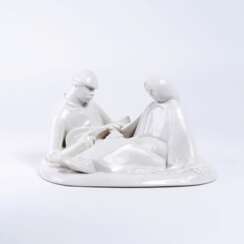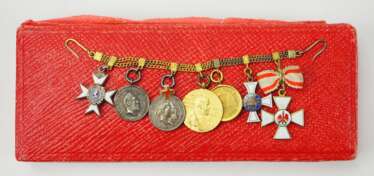schwarzburg 1870

Arthur Storch was a German sculptor and porcelain modeller.
Born and raised in a family of artists, Storch was trained as a modeller at the Volkstädter porcelain factory and then studied at the Bavarian Academy of Fine Arts. Having established himself as a sculptor and medallist, he worked in Munich and Hamburg, and contributed to architectural jewellery in cities such as Wiesbaden and Hamburg. His legacy includes around 100 drawings, 12 medals and 40 sculptures.



Arthur Storch was a German sculptor and porcelain modeller.
Born and raised in a family of artists, Storch was trained as a modeller at the Volkstädter porcelain factory and then studied at the Bavarian Academy of Fine Arts. Having established himself as a sculptor and medallist, he worked in Munich and Hamburg, and contributed to architectural jewellery in cities such as Wiesbaden and Hamburg. His legacy includes around 100 drawings, 12 medals and 40 sculptures.


Arthur Storch was a German sculptor and porcelain modeller.
Born and raised in a family of artists, Storch was trained as a modeller at the Volkstädter porcelain factory and then studied at the Bavarian Academy of Fine Arts. Having established himself as a sculptor and medallist, he worked in Munich and Hamburg, and contributed to architectural jewellery in cities such as Wiesbaden and Hamburg. His legacy includes around 100 drawings, 12 medals and 40 sculptures.


Arthur Storch was a German sculptor and porcelain modeller.
Born and raised in a family of artists, Storch was trained as a modeller at the Volkstädter porcelain factory and then studied at the Bavarian Academy of Fine Arts. Having established himself as a sculptor and medallist, he worked in Munich and Hamburg, and contributed to architectural jewellery in cities such as Wiesbaden and Hamburg. His legacy includes around 100 drawings, 12 medals and 40 sculptures.

.jpg)
Ernst Heinrich Barlach was a German expressionist sculptor, medallist, printmaker and writer. Although he was a supporter of the war in the years leading to World War I, his participation in the war made him change his position, and he is mostly known for his sculptures protesting against the war. This created many conflicts during the rise of the Nazi Party, when most of his works were confiscated as degenerate art. Stylistically, his literary and artistic work would fall between the categories of twentieth-century Realism and Expressionism.

.jpg)
Ernst Heinrich Barlach was a German expressionist sculptor, medallist, printmaker and writer. Although he was a supporter of the war in the years leading to World War I, his participation in the war made him change his position, and he is mostly known for his sculptures protesting against the war. This created many conflicts during the rise of the Nazi Party, when most of his works were confiscated as degenerate art. Stylistically, his literary and artistic work would fall between the categories of twentieth-century Realism and Expressionism.

.jpg)
Ernst Heinrich Barlach was a German expressionist sculptor, medallist, printmaker and writer. Although he was a supporter of the war in the years leading to World War I, his participation in the war made him change his position, and he is mostly known for his sculptures protesting against the war. This created many conflicts during the rise of the Nazi Party, when most of his works were confiscated as degenerate art. Stylistically, his literary and artistic work would fall between the categories of twentieth-century Realism and Expressionism.

.jpg)
Ernst Heinrich Barlach was a German expressionist sculptor, medallist, printmaker and writer. Although he was a supporter of the war in the years leading to World War I, his participation in the war made him change his position, and he is mostly known for his sculptures protesting against the war. This created many conflicts during the rise of the Nazi Party, when most of his works were confiscated as degenerate art. Stylistically, his literary and artistic work would fall between the categories of twentieth-century Realism and Expressionism.

.jpg)
Ernst Heinrich Barlach was a German expressionist sculptor, medallist, printmaker and writer. Although he was a supporter of the war in the years leading to World War I, his participation in the war made him change his position, and he is mostly known for his sculptures protesting against the war. This created many conflicts during the rise of the Nazi Party, when most of his works were confiscated as degenerate art. Stylistically, his literary and artistic work would fall between the categories of twentieth-century Realism and Expressionism.


Arthur Storch was a German sculptor and porcelain modeller.
Born and raised in a family of artists, Storch was trained as a modeller at the Volkstädter porcelain factory and then studied at the Bavarian Academy of Fine Arts. Having established himself as a sculptor and medallist, he worked in Munich and Hamburg, and contributed to architectural jewellery in cities such as Wiesbaden and Hamburg. His legacy includes around 100 drawings, 12 medals and 40 sculptures.

.jpg)
Ernst Heinrich Barlach was a German expressionist sculptor, medallist, printmaker and writer. Although he was a supporter of the war in the years leading to World War I, his participation in the war made him change his position, and he is mostly known for his sculptures protesting against the war. This created many conflicts during the rise of the Nazi Party, when most of his works were confiscated as degenerate art. Stylistically, his literary and artistic work would fall between the categories of twentieth-century Realism and Expressionism.

.jpg)
Ernst Heinrich Barlach was a German expressionist sculptor, medallist, printmaker and writer. Although he was a supporter of the war in the years leading to World War I, his participation in the war made him change his position, and he is mostly known for his sculptures protesting against the war. This created many conflicts during the rise of the Nazi Party, when most of his works were confiscated as degenerate art. Stylistically, his literary and artistic work would fall between the categories of twentieth-century Realism and Expressionism.










































































